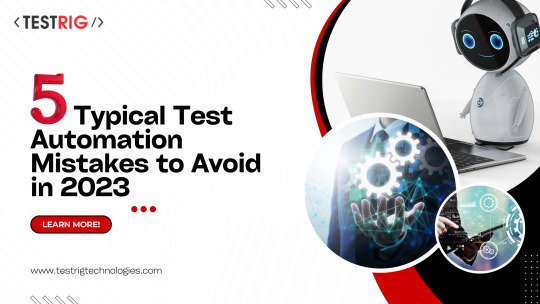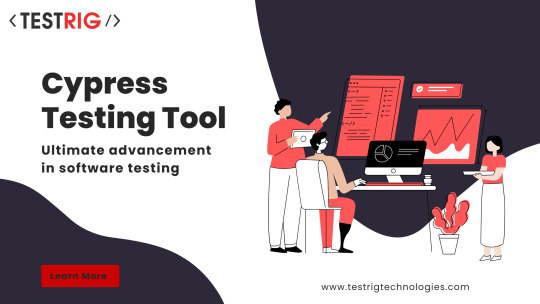Don't wanna be here? Send us removal request.
Text
How to Test your E-learning Mobile Application

The E-Learning market size surpassed the figure of USD 315 billion in 2021 and is projected to observe a 20 percent CAGR from 2022 to 2028, states the E-learning market size states a report by Global Market Insights, a market research firm. Access to high bandwidth internet and smartphones, clubbed with cost-effective learning options are acting as growth drivers of the e-learning market. To accelerate growth, companies need to build high quality applications with a great user experience that can help in user growth and retention. Extensive Testing of the applications can help in delivering quality applications to users.
This article on ‘How to test your e-learning mobile application’ can help you test your mobile application and improve its quality.
So let's begin.
Different modules in E-learning application:
As per the user:
Admin module
Students module
Teachers module
As per course content and functionality:
Exam module(To conduct exams and tests)
Study module(Live and recorded classes)
Content module(Availability of study material)
Attendance module
Payment module
Helpline module
Some Types of Testing that you can implement while testing your mobile application:
Functionality Testing
Usability Testing
Performance Testing(load and stress)
Security Testing
Compatibility Testing
Compliance Testing
Content to be Tested :
Course Content
User-friendly application
Visuals – Images and Graphics
Audio-Visuals
Quiz and Assessments functionality
User access
Some basic Test cases to test e-learning mobile applications.
The user should be able to see all his course modules.
Use should be able to access all the modules.
All buttons, check boxes, and other UI elements on the page should be accessible and working.
The user is routed to the expected page after the user clicks on the button.
All text content should have proper grammar and spelling.
Video content has pause, play, close, and scrolling options.
Video content should have clear audio and subtitles.
All images should be aligned properly and clearly visible.
There should not be any bad links in the application.
The application functionality should be flawless.
Test case as per module:
Attendance module
The user should have access to the attendance module
The attendance should have correct visibility of the days the user has attended the classes.
The user is able to mark the attendance by clicking on the button.
2. Payment module
The user should be able to select a new course module
The user is navigated to the payment module when he clicks on the payment option
During the payment process user can change the payment gateway
The user is able to successfully reach the payment module
The user gets a message after successful payment.
Check what happens if the payment is unsuccessful.
Check what happens if the payment is pending.
3. Course content module
Check if the user can download study material.
Check if the downloaded material is present in the user's account.
4. Study module
Check if the user can attend all online classes
Check if the user can access all offline classes
Check if the user can successfully chat with the instructors.
Check if the user gets messages from the instructors.
5. Helpline module
Check if the user can connect to instructors after clicking on the phone buttons
Check if the user can send a message to the instructor in the chat option
6. Exam module
Check if the user is able to access all the quizzes and exams section
Check if the user is able to access his gradings section
Check if data is updated in the grading section.
As E-learning applications are used by thousands of users across the globe, it is necessary that the application is able to cater to the load and stress on the application. This is why we need to test the application for performance so that the application delivers a great user experience. Similarly, as the application has a payment module we need to test the application for security, and the application should meet the Open Web Application Security Project (OWASP) standard.
Similarly, as an E-learning application should be accessible to users of all groups the application should comply with Web Content Accessibility Guidelines.
Conclusion:
While it would be difficult to cover all the test cases used in testing the e-learning application, this article covers a brief overview of some test cases which need to be executed while building an e-learning application. Testing the application ensures that the application is robust and meets end-user requirements.
Building a great application can help users and also help the company as users of the applications are bound to grow if the application is user-friendly and functionally good.
As a Top iOS App Testing Company, At Testrig Technologies we follow an extensive QA process to ensure the applications are tested thoroughly to build better quality applications.
Let us know what your QA challenges are, and our QA experts will be happy to help you out.
0 notes
Text
3 Reasons Why Businesses Need to Care about Edge Cases in Testing

Edge cases in the field of software testing are cases that affect a small number of users and are not a widespread issue. However, it is important for businesses to handle and fix the edge cases before it leads to a major financial loss. While in some cases, edge cases can be a minor issue while in some situations, edge cases can lead to a major catastrophe. So is it wise to test for edge cases?
This article on why businesses should care about edge cases in testing will clear your doubts about testing edge case scenarios.
So let’s begin
1. Edge cases causing severe losses
In the field of software testing, it is always said that ‘No Testing is Enough’. Considering the time and cost involved in testing edge cases, businesses might tend to avoid testing their product for edge cases. However, businesses need to take a call on edge case testing based on the type of customers being affected by the edge case bug. Consider a situation where one of the customers of a banking application is facing an issue while using the application. Although the issue is faced only by one customer, as the sole customer is a major revenue generator for the company, they need to provide a solution for the edge case, or else it might lead to a major loss for the company. This is why we need to care about edge cases while testing our product.
2. To build a robust product
Now consider another situation where a part of an application that has an edge case bug is used by only one percent of the users. The cost of fixing that bug can be way out of proportion cost-wise, and it might happen that the bug might not be worth fixing, but you know the bug is still there. However, fixing that bug can build a robust product and improve the product quality and enhance the brand reputation.
3. Deliver a great user experience
Edge cases can lead to usability problems. This can lead to users abandoning the application because of bad experiences. Apart from ensuring no errors functionality businesses also need to ensure that the application delivers a perfect user experience or else users would not hesitate to abandon their application.
Conclusion:
In the above article, we saw the need to fix edge cases and how fixing these cases can make the product robust and improve product quality. However, the decision to fix these edge cases depends on a number of factors. Although it is advisable to fix such cases, the decision is taken based on the factors like the cost involved, the time required to fix it, and the number of users affected. Businesses need to ensure that their test suite covers testing for edge cases. A good set of regression test cases should enable businesses to find most of the uncommon edge cases which can help them improve their application quality.
Looking to test your application for edge cases?
QA experts with deep domain knowledge at Testrig Technologies can help test your application for edge scenarios.
To talk to our QA experts, connect with Testrig Technologies
0 notes
Text
Integrating AI in Software Testing: Pros and Cons

The uses of today go beyond simply one level. They take into account several features and components of a user's engagement, delighting them with APIs, utilizing legacy systems, gaining access to databases, and simultaneously sending them push alerts. A lot of effort and trial-and-error methods are required to make anything like that happen.
Software testing enters the picture in this situation. The difficulties in testing software and apps have never been as great or difficult as they are now. Add quality assurance and control to the equation, and you have a mountain that appears more difficult to scale than the formidable Everest.
Thank goodness, AI is here to lift our spirits. Some people genuinely think artificial intelligence (AI) will transform quality assurance and control by magic. The secret is using artificial intelligence to validate the enormous, ever-growing volumes of code we now possess. Can we do it? Is this a power that can be learned? Explore now.
The benefits of using AI in product testing include:
Now let's examine the specific instances when AI provides software testing with a better option than what is currently on the market.
Saving time and money:
Saving time and money is the initial and most evident benefit of AI in software testing. Apps have millions of lines of code, and these lines are updated and altered virtually every day. All code changes require testing, and manually repeating such tests may be expensive in terms of time and money-consuming.
To the rescue, automated testing! Automation, one of AI's most fundamental applications, may be used to speed up repetitive software testing at no additional expense.
Even results that are beyond the capabilities of humans can be helped by AI. As an illustration, can human skills manage a controlled app or software test with thousands, or even only a few hundred users? Most likely not.
Accuracy:
Accuracy is another area in which testing by humans might fall short. Errors are going to go undiscovered when there is so much code to examine and run. Even the most meticulous testers occasionally make mistakes and fail to notice a minor software design flaw.
How does AI assist in these situations?
One benefit is that it makes it exceedingly simple and effective to automate testing involving thousands of individuals. To conduct an exhaustive test, these "virtual" users communicate with the database, network, and software.
The second benefit is that AI won't ignore errors as humans may. Because that's how computers operate, automated testing software will thoroughly examine each line of code and report any problems. Now, testers may use their human potential to solve original problems or cope with the testing of complex features.
Cons of AI-based Software Testing
Despite the immense potential that AI has for software testing, we must acknowledge that there are some fundamental problems in the way that AI is currently used in software testing. It will be fascinating to observe how they change over time.
Need human direction to offer clarification:
Those who anticipate that AI will replace people in the field of software testing should turn aside! The labor-intensive aspect of manual testing that we loathe will be replaced by AI. We have made headway on those with API testing tools, but completely automated and intelligent testing is still some way off. We still need to monitor, input and adjust the behavior of our artificial intelligence (AI) using human input.
No compassion:
Robots, artificial intelligence software, and computers are renowned for not having emotions. That occasionally might provide a challenge when it comes to software testing. Your program could work flawlessly and accomplish everything you need it to, but it might also take an eternity to load. This lengthy loading time would elicit an emotional response from human testers, which would be annoying for consumers. However, AI testing would entirely skip this step and wait till the program loaded for its fair portion of time. The AI can wait there all day long without having to board a train! Your users are unable. We think AI is still faulty in this area.
To sum up:
Businesses all across the world employ strong AI-powered technologies to automate and accelerate software testing. Yes, human assistance is necessary since these technologies aren't yet intelligent enough to pick up new skills and develop over time. You cannot entirely avoid the realm of software testing as a human (at least not right now)!
For the time being, software testing recipes require a perfect basis of human talent with a dash of AI. AI in software testing certainly has more benefits than disadvantages. Regarding the future? Follow along to learn what happens. To put it mildly, it will be quite fascinating.
At TestRig Technologies, we provide AI-driven software testing consulting services to help our clients get the most out of their testing efforts. We use the latest AI technology to provide insights and recommendations that can help improve the quality of your software products.
2 notes
·
View notes
Text
How to Integrate Cypress with Cucumber BDD?

The advent of the Behavior-Driven Development (BDD) framework has led to increased engagement of product owners in the product development process. BDD framework helps to achieve all the prospects of a technical or the business team. It puts great importance on the business value and needs. With BDD gaining importance, new test automation tools cannot afford to ignore this framework and so these tools offer the feature of testing using BDD framework.
In order to cover all the capabilities of Cucumber, Cypress provides and integration with the Cucumber BDD framework, and in this article, we will be discussing how the framework can be integrated with the Cypress tool so that you can take benefits of BDD framework using Cypress.
What is Cucumber BDD testing?
Cucumber is a Gherkin-based testing tool that supports Behavior Driven Development (BDD).
Gherkin uses plain English language to write behavior scenarios. It offers a way to write test scenarios that anybody can understand, regardless of their technical knowledge.
In BDD, users first write scenarios or acceptance tests that describe the behavior of the system from the customer’s perspective, for review and sign-off by the product owners before developers write their codes.
Feature file:
These files contain Cucumber tests and have a ‘.feature’ extension.
Each scenario represents one test in the form of scenarios in the Given-When-Then form.
Step definition file:
The step definition file contains the actual code which stores the mapping between each step of the scenario defined in the feature file with a code of the function to be executed.Step definition files are .js files.Later during the execution of each test Cucumber scans the step definition file for each scenario mentioned in the feature file and executes the code.
What is Cypress?
Cypress is a JavaScript-based front-end testing tool used for web test automation.
Advantages of Cypress
Debuggability: Cypress helps you to debug your tests directly from familiar tools like Developer Tools.
Automatic Waiting: The automatic wait feature of Cypress never add waits to your tests. It automatically waits for commands and assertions before moving on to the next step.
Fast and Consistent Results: Cypress tests run in the browser and so the execution is fast. Cypress also provides consistent and reliable tests that are flake-free.
Screenshots: Cypress helps us view screenshots taken automatically on failure.
Cross-browser Testing: Cypress supports cross-browser testing across five different browsers
Benefits of Using Cypress Cucumber Integration
The integration of Cypress tool and Cucumber becomes a power pack solution for test automation. On one side you can cash in on the speedy execution of Cypress and on the other side you can use the BDD framework support provided by the Cucumber tool. The integration of Cypress and Cucumber is easy to set up as you need not set up or configure browser-specific drivers.
Steps to integrate Cypress with Cucumber and run your test
1. To integrate Cypress with Cucumber you need to Install the cucumber plugin by running the following command
npm install –save-dev cypress-cucumber-preprocessor
2. Once the plug-in is installed you need to add this code snippet in the index.js file under the plugins folder. This will help in making the cucumber plug-in recognizable to other cypress files.
const cucumber = require('cypress-cucumber-preprocessor').default
module.exports = (on, config) => {
on('file:preprocessor', cucumber())
}
3. Another important step you need to include is to inform cypress to recognize the .feature extension files of cucumber. You can do this by adding the following lines in the cypress.json file
{
"testFiles": "**/*.feature"
}
In case you want cypress to also recognize the .js extension then you need to add the following lines in the cypress.json file.
{
"testFiles": "**/*.{feature,js}"
}
4. Following this, you need to add the following in the package.json file
"cypress-cucumber-preprocessor": {
"nonGlobalStepDefinitions": true
}
5. Once you are done with writing your feature file you just have to go into the directory ../BDD-with-cypress-cucumber/cypressCucumber/ and open the cypress dashboard, using the command node_modules/.bin/cypress open and run the test using node_modules/.bin/cypress run --browser chrome.
To conclude, we can see that Cypress provides you the facility of running your tests in the BDD framework with ease. Using Cypress and Cucumber together helps you draw the benefits of both tools for your project. It also helps in increasing the test coverage and covering key business scenarios together.
To know more about test automation with Cypress contact Testrig Technologies.
0 notes
Text
Cross Browser Testing with Cypress
Cross Browser Testing is an important step in application testing as it helps verify your application’s compatibility with different browsers. Each browser interprets information in a different way and cross-browser testing can help you to detect compatibility issues. Solving these issues can enhance the efficiency and user experience of your application.
Cross-browser testing can be done in multiple ways including manual cross-browser testing and automated cross-browser testing. In the manual method, testers execute the manual test cases by selecting different browsers one by one. While in automated testing testers write test scripts in test automation frameworks like Cypress to run on different browsers.
We at Testrig Technologies would like to bring to you this article that can guide you on different ways to perform cross-browser testing in Cypress.
With the latest release, the Cypress test automation tool can run tests in browsers like Chrome, Electron, Brave, Edge, and Firefox. To run the cross-browser compatibility tests, Cypress provides two options, one to run your tests via the Command Line Interface and the other directly from the Cypress test runner.
Choose your browser through the Test runner
In the Cypress test runner, you have the provision to switch the browser by using the drop-down near the top right corner. As Cypress automatically detects available browsers on your operating system and if a browser option is not available in the test runner, it means you need to download the latest version of the browser in our system.
Note that Cypress supports the browser versions below:
Chrome 64 and above.
Edge 79 and above.
Firefox 86 and above.
Choose your browser through CLI mode
Cypress provides the option to run your tests through CLI mode for cross-browser testing. You have to run the following commands to execute the tests in different browsers.
For instance:
To run the execution in Firefox, you need to run the command
cypress run -- browser firefox
To run the execution in Chrome, you need to run the command
cypress run -- browser chrome
3. To launch Cypress with a specific browser you can use, npm scripts
like
“Scripts” :
{
“cy:run:chrome”: “cypress run –browser chrome”,
“cy:run:firefox”: “cypress run –browser firefox”
}
Apart from this Cypress also provides other features like continuous integration, periodic run through cron scheduling, parallel run per browser, and run specific tests per browser, for running cross-browser tests.
Sample code for running parallel test :
cypress/run:
name: Chrome
requires:
- cypress/install
executor: cypress/browsers-chrome73-ff68
record: true
start: npm start
wait-on: http://localhost:3000
parallel: true
parallelism: 4
group: chrome
browser: Chrome
Sample code to run specific tests per browser:
// using the built-in Electron browser
it('has access to clipboard', { browser: 'electron' }, () => {
...})
// if Cypress is run via Firefox
it('Download extension in Firefox', { browser: 'firefox' }, () => {
cy.get('#dl-extension')
.should('contain', 'Download Firefox Extension')
})
Sample code for a periodic run through cron scheduling
version: 2.1
orbs:
cypress: cypress-io/cypress@1
workflows:
nightly:
triggers:
- schedule:
cron: '0 0 * * *'
filters:
branches:
only:
- master
jobs:
- cypress/run:
executor: cypress/browsers-chrome73-ff68
browser: firefox
start: npm start
wait-on: http://localhost:3000
Where the expression 0 0 * * * translates to "every day at midnight" or nightly
Code Source: Cypress.io
Conclusion:
Software products, if not tested for cross-browser compatibility can lead to business losses. This is where cross-browser testing plays an important role. We at Testrig Technologies provide cross-browser testing services using different tools to check your product across thousands of different combinations of devices and browsers to make your product robust and market ready.
To know more about Cypress test automation solutions contact Testrig Technologies.

0 notes
Text
Five Typical Test Automation Mistakes to Avoid in 2023

The uptake of test automation has significantly increased. This might be attributed to enterprises' increasing reliance on routine application and system testing.
Surprisingly, though, only a small number of businesses have been successful in maximizing the advantages of test automation. For the majority of businesses, mistakes in test automation might be perceived as a serious impediment.
Following discussions with industry consultants and test automation experts, we've listed 5 test automation errors that are frequently made along with solutions.
Testing Automation as a Change
Without a doubt, automation is viewed as a practical way to support testing efforts. Enterprises and test professionals, however, view it as a substitute for manual testing, which prevents them from doing sufficient testing and coverage. It is preferred to see automated testing as a method above manual testing.
Create a list of testing aspects that can be automated. You might test a web page with inconsistent typefaces, for example. In this case, you should solely automate the script's analysis of font-related issues.
Playback and Recording of Test Scripts
Most testers are in charge of managing the usage of records and back for framing test scripts. The record characteristic must be seen as a phase in the process of writing a basic script, nevertheless. A customized version of the created script is necessary for a successful automation test, to put it simply.
Data parameterization, or the introduction of checkpoints for support, is covered by script customization. Additionally, script modularization may be used to allow several testers to work simultaneously.
Ignore Validation
Enterprises and functional testing frequently employ unvalidated test scripts. There are instances when test scripts do need validation to perform a certain action. Taking the automated tests of a website with a login page as an illustration. In this case, it is necessary to confirm the fact that the login was successful.
Checkpoints can be used to validate scripts. The use of checkpoints enables the detection of web objects, site parameters, or maybe some text. As so many points as feasible should have checkpoints.
Only Allow Visible Validation
Another problem arises when application testers are only allowed to verify visible items while avoiding other components. Validations must always extend to non-visible components as well, such as page content and visible buttons.
Do offer confirmations highlighting the end of the procedure. For instance, it is a key necessity to search the database to confirm that the order was properly stored if you are operating an order input system or placing an order.
Putting off Maintenance
It's not at all easy to automate tests. Test automation is improved and kept up to date over time, much like many other elements of software development. Teams frequently release test cases intending to send the message that perhaps the automated process is complete. Upgrades to the test cases and automation code are undoubtedly made as a result of the evolution of a particular piece of software.
The truth is that many testing professionals who work with test automation don't see the necessity to keep automated scripts up to date. Many of them have a history of entirely ignoring maintenance for extended periods. Such a choice has negative effects on test automation velocity, unit testing, and software quality.
Update automated testing scripts and unit tests as soon as the program begins to change. Additionally, do not put off updating automated test scripts. Setting out time specifically for the upkeep of automated testing is a wise move.
Conclusion
There is no disputing that the majority of testers may have made one or more of the errors listed above. This article offers a clear resolution to problems with test automation that are currently plaguing testing efforts. It is advised to avoid ignorance and speak with experts in software testing who can provide further information and support.
At Testrig Technologies, you can get in touch with qualified automation testers that can address your test automation difficulties with the appropriate automation testing services.
0 notes
Text
Complete Guide To Understand Limitations of Selenium Webdriver

More businesses are trying to include automated testing into their software development lifecycle as it gains popularity. Automation may expedite the testing process and increase coverage, but it can also be difficult to master.
In this blog article, we'll go through some of the most typical obstacles that testers encounter while deploying test automation and provide advice on how to get beyond them.
The following are a few difficulties with Selenium WebDriver:
We are unable to test mobile applications.
We can test on any desktop operating system and browser using Selenium, but we can't test on mobile devices with Selenium alone. However, there is a fix for this.
The WebDriver protocol may be used by Appium to manage native, mobile, and hybrid iOS and Android apps. You may test your application on native mobile operating systems using Appium. Instead of using online applications, Appium automates the testing of mobile apps.
Small reporting
Selenium lacks in-built reporting functionality and hence plug-in’s like TestNG or Junits are used to produce reports. These reports will display data such as the pass/fail percentage, execution time, faults, etc.
Taking care of dynamic elements
When you initially visit the website, several of the web parts are dynamic and aren't immediately apparent.
When an element's id changes with each page load, managing that element in a typical manner might be challenging.
With dynamic XPath or dynamic CSS selectors, we must deal with the dynamic components. To manage dynamic objects, functions like starts-with, contains, ends with, etc., are useful.
Dealing with page load
There are certain user-specific websites. These user-specific pages load various components based on the user. Depending on an earlier activity, some items can occasionally surface.
Cities connected to the nation you select in the country dropdown will load in the cities dropdown.
Selenium script may fail to recognize the element during execution. This may be avoided by using explicit waits in the script, which give the components adequate time to load and be recognized.
Dealing with pop-up windows
Pops that run on Windows are included with the operating system. Sometimes it's challenging to automate a straightforward prompt or confirmation alert pop-up. Selenium does not support native dialogue windows that are based on the operating system. The limits of selenium are reached.
To manage the popups based on Windows, we may utilize AutoIT.
Processing captcha
Another difficulty with Selenium testing is dealing with a captcha. Although several third-party programs are available to automate the captcha, we still can't get perfect results.
The choices listed below can help us resolve this problem:
-Turn off the captcha entirely in the testing environment.
-Make the captcha system accept a fake value in the test environment.
Inference
There have been automation tools for a while. They have assisted testers and developers in automating monotonous processes that would otherwise be time-consuming, tiresome, or just plain dull. But much like everything else in the digital world, automation is always changing to match the demands of modern software development teams. These technologies present additional difficulties for individuals who use them, such as Selenium WebDriver's limits and the difficult technical debt brought on by test automation, but they also present fresh chances for development.
If you're looking to surmount selenium test automation difficulties, reach out to us at Testrig Technologies.Hire Selenium Tester
0 notes
Text
Performance Testing for E-Commerce Application

Who wouldn't want their app to receive a lot of traffic, especially if it generates a lot of money? If you correctly test and optimize programs for performance, wishes can come true. When it comes to e-commerce applications, you must be very cautious. Your app may debut a new product or provide a discount, but if heavy traffic hinders its functionality, it may crash. This will be detrimental to a company's success because your e-commerce app is essential to both your expansion and your reputation.
Test your e-commerce application
Your applications may be tested using modeling or performance testing. By simulating the full situation, modeling is a technique that uses software to construct a "what if" scenario. On the other hand, the application is executed on a system, and performance is monitored using the performance testing approach. To determine the app's effectiveness in a bigger setting, it is evaluated on a controlled software platform.
A variety of different types of tests are used in performance testing to examine various elements of an application. Through load testing, which is one kind of performance testing, testers attempt to gauge how the app will function when both the number of users and the number of transactions considerably rise. Any problems that surfaced during testing may be resolved to ensure that the application operates as expected after launch.
Why Should You Test Your App's Performance?
You may better comprehend how an application behaves under load by doing performance testing. Performance testing of the app evaluates the app's response time, money generated from incoming visitors, and other factors.
Additional advantages of performance testing include:
Identifying and correcting any flaws Performance testing- it enables you to identify defects far sooner and correct them, whether they are in the coding infrastructure of the app or in how users interact with it. When the app is first introduced to the market, it is flawless and operated at its peak.
Equipment specifications - Performance testing enables you to understand how your app will respond to changes in traffic volume, sluggish servers, network problems, etc. Thus, you may modify the hardware requirements for your program as necessary. This helps you avoid major humiliation down the road, should the app not work as intended.
Release with assurance - Overall, it helps you feel confident in releasing an application that won't let down the users. When the outcomes have been tested and evaluated beforehand, you can be sure that the application will accomplish its goal.
How to Conduct Effective Performance Testing for Your E-Commerce Apps?
After examining the benefits of performance testing, let's examine the proper methodology. The test environment is essential in this and must be as similar to the real environment as feasible. Before launching, the three components that need to be checked are speed, scalability, and stability.
Hardware and software both have an impact on test circumstances. However, due to the costs involved, it might not be viable to recreate the complete ecosystem. The project and its circumstances should be scaled back in this situation, and it should then be tested.
Any potential consumer, anywhere in the world, should be able to readily use an e-commerce app. To make sure the program works properly everywhere, testing is required. This increases the number of factors, such as operating system, device, browser, etc., that must be taken into account for optimal working, yet the app still needs to work flawlessly regardless of the user.
Many e-commerce applications don't generate income from their visitors because customers frequently abandon carts before making orders. This could be due to speed, thus the app must react rapidly to user feedback.
An e-commerce app's fault tolerance and attack susceptibility are both investigated during load testing. Additionally, testing will reveal any potential backup issues, content analysis, personalization functionality, language support and presentation, order and payment processing, and order tracking capabilities. To guarantee that users have the best experience and that companies can maximize revenues, the performance testing procedure will look at every component of the app.
Hiring a QA tester is the perfect way to find bugs in your eCommerce application before it goes live. You'll be able do this with our help and make sure that everything runs smoothly on launch day!
0 notes
Text
6 Best Practices to Conduct Application API Testing

One of the most significant forms of software testing is API testing, or application programming interface testing.
The challenging chore of handling numerous test cases is made simpler by API testing automation. The "boiling frog phenomenon" refers to the problem of managing an increasing number of test cases when additional features are slowly added to the software. With automated testing, you can manage millions of test cases and these intricacies with ease.
Due to the design and creation of each test case, API testing without automation might take longer. So, by improving test case management, automating API testing reduces time to market and increases scalability.
The significance of cloud-based APIs has also been highlighted by the recent epidemic. 75% of companies that monitor their IaaS/PaaS setups will use cloud-based APIs to consume metrics, according to Gartner.
Therefore, API testing automation is crucial if you want to improve cloud-based APIs or even the effectiveness of third-party integrations.
Here are 6 effective Practices to conduct API testing:
Automation Plan
Planning is the foundation of any project, regardless of whether you're creating an application, moving to the cloud, or simply testing software. Similar to this, you must prepare for API testing automation. Resource acquisition for test automation is one of the crucial things you need to plan for.
API test automation requires software and infrastructure, both of which require resource allocation. Therefore, if not accounted for, the overall API testing expense may exceed the established ceiling.
Prioritization is a further consideration. Therefore, you don't have to automate every test case. The test cases that provide precise findings, however, are typically time-consuming, have a high failure rate, and include reliable aspects that are most likely to be automated.
Unit tests, API tests, regression tests, security tests, and cross-browser testing are examples of test scenarios you may automate. There are test cases that you can perform manually at the same time, such as UX testing, app accessibility tests, native feature tests, functionality tests, and anti-automation features.
These test cases shouldn't be automated because of how many false positives they provide as results and how expensive test automation is. Additionally, after you have the automation plan prepared, you should consider the execution strategy because the implementation may be much more complicated than you had anticipated.
API test automation approach
API test automation approach requires a framework to harmonize testing procedures across all testers. As your teams grow, standardization can help you provide a clear set of instructions that will be useful to new testers. among the most popular frameworks for test automation are
Testing professionals use the straightforward Linear Framework to create and execute test scripts. The linear architecture is comparable to capturing a video and then reviewing it to see any changes.
A modular framework enables you to divide each test case into modules, which are comparatively smaller components. These units are managed by the master script and are independent of one another.
As a result of the consistency of the test case execution provided by the master script, testers may streamline their workflow and save time.
It is a framework that enables the division of test cases into smaller components and the creation of groups of modules that perform the same functions. These groupings are further saved in a library and are based on the same test script.
These units may be reused as they are based on the same test script, increasing the adaptability of API test automation.
Tools for Automation Testing
Tools for API automation testing can help with mistakes that manual testing sometimes makes. In addition to accuracy, automation allows for scale to handle more test cases. The finest part is incorporating an API testing automation tool into your continuous integration (CI) pipeline and raising the quality of the code by accurately identifying issues.
The ideal testing environment
The success of the automated testing strategy depends on configuring the appropriate testing environment. Making ensuring the testing and development environments are the same and consistent is the first step. To avoid issues with refactoring, you should also check to verify if the test environment is compatible with your present system.
It's important to specify data access and flow clearly to automate API testing. Configure various features, such as what happens to data after testing and from which source the automation tool will get the test case data. Before developing the test cases, establish a set of best practices to adhere to to account for modifications to test environments.
It's time to create test cases now that you've decided on the test types, developed a strategy, and set up the environment.
Creating Tests
How the test cases will be run is one of many elements that must be carefully taken into account while designing the tests. Are the test scripts adaptable to changes in automation? There are two different ways to test design that you may use:
User stories may be included in test scripts using behavior-driven development (BDD).
By altering the data in external files, data-driven development makes it possible to create new test cases.
The next stage is to carry out the API testing for your systems when the test automation design is complete.
Execution & Analysis
The execution of API testing automation is the last stage. To lessen reliance, you can run test cases concurrently here. For instance, the execution of the sign-in test case shouldn't depend on the test case for the download functionality.
By guaranteeing that the execution takes place over a dependable and stable network, unexpected failures may be avoided. A pipeline orchestrating tool that can assist arrange the execution of test cases must also be implemented. Once test cases are run, you can begin evaluating the outcomes to determine what modifications to make to the application.
You can use a variety of market-available third-party solutions for analysis or create a specially designed piece of software. You may use it to find failing test cases, delayed test runs, mistakes, and—most importantly—to keep findings accurate. To identify any false positives, you must compare all of the test cases with the standard documentation from prior test executions.
Conclusion
Because testing automation is a business choice, you must take into account every element of automated API tests. Every project is distinct, and each one has particular testing needs. To make a wise choice, you must comprehend the strategies, test case types, automation frameworks, and execution strategy.
To know more about API testing Go to our website and check out our QA services.
0 notes
Text
Top 7 Features of Postman that every API Tester should know

Postman is a well-known tool for testing APIs that is used by everyone. However, users are frequently taken aback when they learn about the Postman platform's real breadth and depth of capabilities outside of testing.
Visit the matching Postman public workspace and fork it into your Postman setup to test out these potent features for yourself. Here are the 7 Postman features that everyone should be familiar with, linked to collections so you can learn more about each one:
Postman Echo
We studied the service Postman Echo as a little sanity check and educational tool. You may use it to practice making API requests and test your REST clients. The API "echoes" back what you submitted to it, as the name implies, making it an excellent method to examine what you're sending to a server without having to go to backend logs. You may experiment with different parameters, submit requests using multiple protocols (GET, POST, and PUT), and investigate various forms of authentication.
API for Postman
You may access the information kept in your Postman account through programming using the Postman API. On your collections, environments, mocks, and other objects, carry out all the standard CRUD actions. The webhooks folder is, in our opinion, the greatest feature here. With the help of an API request to the webhook URL, you may now start a collection run using this capability. Your unique payload, which can be accessible in the collection, can also be included in requests sent to the webhook URL.
The Visualizer for Postman
A programmatic method of representing your request replies graphically is provided by Postman. We can immediately add visualization for the response body to Postman using HTML, CSS, and JavaScript. Make sense of your answer data by using the Visualizer to show it. To further customize the display, you may import any of your preferred charting libraries, such as D3.js, Chart.js, etc.
Workflow Management
It typically makes sense to run the requests in chronological order in a collection containing numerous requests. Sometimes it's advantageous to repeat or skip some requests. The postman arrives. Method SetNextRequest You can precisely control which requests run and in what sequence by using conditional logic in the Pre-request or Tests tabs.
Cooperative Qualities
In the past, Postman was a tool used for solitary work and independent API testing. Working together has never been simpler thanks to comments, forking, branching, pull requests, tagging, and other features. Make the most of the multiplayer experience with shared workspaces by working together as a team.
Information at the Collection Level
At the same time, Postman makes it simple to adhere to the DRY (Don't Repeat Yourself) software development philosophy for variables, scripts, and auth credentials that will be utilized for several requests in a particular folder or collection. The majority of users are aware that collection-level variables and inherited authentication may be specified. A lesser-known feature, however, is the capacity to create code that will execute before and after each request in the collection in the Pre-request and Tests tabs.
Documentation
It's wonderful to sometimes lighten up in your docs! The Daring Fireball Markdown style, which Postman documentation utilizes, makes it simple to include pictures and gifs in your documentation. When appropriate, feel free to include a humorous gif, such as Michael Scott raising the roof, or just use educational gifs (i.e., a gif showing users how to add params in a request).
0 notes
Text
Cypress Testing Tool: Ultimate advancement in software testing

Cypress is a JavaScript-based, MIT-licensed automation tool that is available for free and open source. It is utilized by organizations like NASA and DHL, and as of the time of this writing, it has over 19.3K stars on Github. Unit and integration tests are simple to develop and debug with the aid of Cypress End-to-End test.
Cypress offers you a visual interface in addition to the test script runner to show you which tests and tasks are currently being executed, passing, or failing. It enables us to test highly interactive apps and run various tests, including changing the DOM, determining whether a certain element is available or visible on the screen, reading or writing data into or from fields, submitting forms, and even rerouting to another website.
Cypress is designed and enhanced as a testing tool. After using Cypress for a while, since Cypress offers a platform to swiftly debug and maintain your code, you could even be tempted to conduct all of your development within it.
It is a cutting-edge front-end testing tool designed for the contemporary web. This solution solves the major challenges that QA engineers and developers face when testing contemporary apps, such as synchronization problems and test inconsistencies caused by parts that were either unavailable or not visible.
It has a Node.js foundation and is delivered as an npm module. It uses JavaScript to write tests because Node.js serves as its foundation. However, 90% of coding may be completed using the clear built-in instructions provided by Cypress.
Along with simplifying HTML DOM tree traversal and manipulation, event handling, CSS animation, and Ajax, it also bundles with jQuery (Javascript Library) and inherits many of jQuery's capabilities.
How is Cypress such a special tool?
-> Cypress is one of the options for Web automation that is easily adaptable due to its various unique features.
-> In comparison to other automation tools, it offers an immediate, constant, and reliable testing process owing to its design and architecture.
-> Cypress waits for instructions and assertions automatically before continuing. Append difficulties are resolved.
-> There is flexibility to replicate the data from the server and test edge test cases.
As your tests are performed, snapshots are taken. Levitating over a function inside the Command Log would tell us specifically what occurred at each phase.
What capabilities does Cypress have to offer?
It offers a variety of capabilities that make the work of a test developer extremely simple:
-> The application can be captured in a snapshot while the tests are executing. Next, as test developers, we may click and drag our mouse over each command in the Test Runner window to observe what transpired at each stage.
-> Debugging is possible with the tests right from well-known tools like Developer Tools. The stack traces and legible errors make debugging quite quick.
-> With Cypress, you can run tests without explicitly adding waits or sleeps. It automatically pauses to await instructions and assertions.
-> Using Cypress's spies and stubs, you may check and regulate the behavior of functions, server replies, or timers at run time, similar to how unit test cases work.
-> By using Cypress, you may control network traffic as you see fit and tailor an API call's answer to your requirements.
-> Results that are consistent across tests are made possible by Cypress's lack of usage of Selenium or Web-Driver and direct execution of tests within the browser.
-> When running from the CLI, it automatically takes screenshots in the event of a failure or records videos of the whole test suite.
Given above are the attributes on which the Cypress tool is based. To think about it, it has been one of the most efficient and reliable testing toolkit to be found. Teams may use it to construct scripts for web test automation. The goal of this solution is to make it possible for fronted developers and test automation engineers to create web tests in JavaScript, which has become the standard web language for automating web tests.
On the other hand, Testrig Technologies provides advanced test automation services for businesses to ensure complete and efficient testing. If you're looking to automate the quality life-cycle, contact us today. We can show you how to maximize test coverage and improve test results.
0 notes
Text
Software Test Automation: Top 5 Challenges

In this article, we are going to talk about the top 5 common challenges while doing software test automation and how to overcome them.
Test automation is one of the key success factors for any software development project irrespective of its size and nature. However, like every other thing in life, test automation also comes with its own set of challenges that need to be tackled effectively for successful implementation.
Let's take a look at those challenges one by one.
Maintaining the test scripts:- One of the most common challenges while doing test automation is maintaining the test scripts. As the software application changes with new features being added or existing ones being modified, the test scripts also need to be changed accordingly. This can be a tedious and time-consuming task if not done properly.
Dynamic content:- Many applications nowadays are built using dynamic content which can be a challenge for test automation. This is because the test scripts need to be able to handle the changes in the dynamic content in order to be effective.
Handling different browsers:- Different browsers render web pages differently and this can pose a challenge while doing test automation. The test scripts need to be able to handle different browsers in order to be effective.
Dealing with the flakiness of tests:- Finally, one of the most common challenges while doing test automation is dealing with the flakiness of tests. Flaky tests are those which give different results on different runs even though there is no change in the application under test. This can be a real challenge while doing test automation and can cause a lot of frustration.
So, these are some of the most common challenges while doing test automation. While they may seem daunting at first, they can be overcome with proper planning and execution. With the right approach, test automation can be a real success for any software development project.
0 notes
Text
Top 5 Quality Principles for successful Test Automation Adoption

It's no secret that automated testing is becoming more and more popular as organizations strive to improve quality and speed up the software delivery process. However, a successful automation initiative requires careful planning and execution in order to ensure that quality is not compromised.
To be successful in your adoption of test automation, you need to have a clear understanding of what makes for good quality. These principles will help guide decisions about which tests are most suitable and how they can best contribute towards improving quality overall across the organization.
Clear and concise Automation Strategy:- The first quality principle for successful test automation is to have a clear and concise Automation Strategy. This strategy should be tailored to the specific needs of your organization and should be based on a solid understanding of your application landscape. It is also important to establish clear success criteria for your automation initiative upfront so that you can measure and track progress.
Choose the right tool:- There is no one-size-fits-all solution when it comes to testing automation, so it's important to select a tool that is best suited for your specific needs. Be sure to consider factors such as cost, scalability, platform support, and integration when making your decision.
Best practices and standards of test automation:- The third principle is to establish best practices and standards for your automation effort. This will ensure that everyone on the team is working with the same toolset and following the same conventions. Best practices and standards will also make it easier to maintain and update your test scripts over time.
Integrate with development:- The fourth principle is to continuously integrate your automation efforts into the software development process. This means that automated tests should be run on a regular basis, preferably with every build. Continuous integration will help to prevent regressions and ensure that new features are properly tested before they are released.
Quality is the priority:- The fifth and final principle is to always keep quality in mind. Automated testing is not a silver bullet and should not be used as a replacement for manual testing. Instead, it should be viewed as a complement to manual testing efforts. By following these principles, you can ensure that your test automation initiative is successful and that quality is maintained throughout the software development process.
If you're looking to improve the quality of your software development process, be sure to check out our blog post on the top five quality principles for successful test automation adoption. By following these principles, you can ensure that your test automation initiative is successful and that quality is maintained throughout the software development process.
0 notes
Text
The Definitive Guide to No Code Mobile Automation Testing for Beginners

In the past, people had to visit a store or call someone on phone for any of these tasks. Nowadays we can do it all from our smartphones and tablets!
With the world changing at a rapid pace, it is evident that more and more people are using mobile devices. In fact in China alone there's been an increase from 636 million users back in 2011 to 1 billion today! This growth has gone hand-in-glove with other developing countries such as India and Bangladesh where smartphone adoption rates have increased by leaps every year since 2008 when they first started tracking data on these phones - respectively reaching 75%+ penetration levels within just five years after Wiggins (2013)
However, this has also resulted in a fragmented mobile device market as different configurations of devices (from various OEMs) are available.
In today's business world, it is more important than ever to ensure that your website and apps are fully cross-browser and cross-platform compatible. With so many different types of devices and browsers available, it can be difficult to test your site or app on all possible combinations. This is where no code mobile automation testing services come in.
In this guide, we will walk you through the basics of no-code mobile testing, so that you can get started right away!
Why automate mobile app testing?
Automation can help to save time and money, increase efficiency and accuracy, and improve the overall quality of your mobile app testing.
Some of the specific benefits of automating mobile app testing include:
1. Increased Efficiency: Automated testing can help you to increase the efficiency of your mobile app testing process. Automation can help you to execute more tests in a shorter period of time, and can also help you to parallelize your testing efforts across multiple devices.
2. Improved Accuracy: Automated testing can also help you to improve the accuracy of your mobile app testing. By automating repetitive and tedious tasks, you can free up your testers to focus on more important tasks, and can also help to reduce human error.
3. Increased Quality: Automating your mobile app testing can also help you to improve the overall quality of your mobile apps. Automation can help you to catch more bugs and potential issues before they are released to users, and can also help you to improve your test coverage.
Overall, automating mobile app testing can provide many benefits that can help you to improve the quality and efficiency of your mobile app testing process. If you are not currently using automation for your mobile app testing, it may be worth considering adding it to your workflow.
What Is No-Code Mobile Automation Testing?
No-code mobile automation testing is a process of automating the testing of mobile applications without the need for coding. No-code mobile automation testing can be used to automate the testing of various types of mobile apps, including native, hybrid, and web apps. No-code mobile automation testing can be used to test the functionality, performance, and security of mobile apps. No-code mobile automation testing can be performed using various tools and frameworks, such as Appium, Calabash, and Robotium.
The goal of any type of no-code (or codeless) automation testing is to minimize the effort involved in creating and maintaining scalable, reliable tests. The tool helps with test creation without writing a single line code which can be difficult for some people who may not have programming experience.
Benefits of No-Code Mobile App Testing
There are many benefits to no-code mobile app testing. Perhaps the most obvious is that it can save you a lot of time and effort. With no code to write, you can get your app up and running much faster than if you had to code it from scratch.
No-code mobile app testing can also be a great way to learn about coding. If you're new to coding, it can be a great way to get your feet wet and see how everything works. You can also use no-code mobile app testing to experiment with different features and functionality before you commit to writing any code.
Another big benefit of no-code mobile app testing is that it can help you save money. If you're not a professional coder, you might not be able to justify the expense of hiring one. But with no-code mobile app testing, you can create your app for free or for a much lower cost.
Finally, no-code mobile app testing can be a great way to get feedback on your app before you launch it. If you're not sure how something will work or look, you can test it out with no-code mobile app testing and get feedback from real users. This can help you make sure your app is ready for launch.
1 note
·
View note
Text
Tips And Tricks For Becoming A Master Software Tester
Do you want to be a master software tester? If you're looking for tips and tricks to help you improve your skills, you've come to the right place. In this blog post, we will discuss some of the best ways to become a top-notch software tester. We'll cover everything from how to find defects early in the development process to how to effectively communicate with developers. So whether you're just starting out in your software testing career or you're looking for ways to take your skills to the next level, read on!
1. One of the most essential skills for a software tester is the ability to find defects early in the development process. The sooner you can find a defect, the easier it is to fix. There are many ways to find defects early. One way is to test early and often. Ensure you're testing every time there's a new build or change to the code. Another way to find defects early is to use static analysis tools. These tools can help you identify potential problems in the code before it even runs.
2. Once you've found a defect, it's important to be able to effectively communicate with developers. They need to know what the problem is and how you found it. They also need to know what you expect them to do to fix it. Be clear and concise in your communications, and make sure you're always on the same page.
3. Read books and articles on software testing. There is a wealth of information available on this topic, and by reading as much as you can, you will be able to gain a better understanding of the different concepts and techniques involved in software testing.
4. Take an online course or two. There are many great online courses that cover various aspects of software testing. By taking one or two of these courses, you will be able to learn more about the topic and will also be able to get some hands-on experience.
5. Attend conferences and seminars. There are often conferences and seminars held on software testing. Attending these events can help you network with other professionals in the field and can also give you the opportunity to learn from the experts.
6. Get certified. Getting certified in software testing can help you show potential employers that you are knowledgeable about the topic. There are many different certification exams that you can take, and by passing one of these exams, you will be able to demonstrate your expertise in the field.
7. Keep up with the latest trends. Software testing is an ever-changing field, and it is important to stay up-to-date with the latest trends. By reading industry publications and attending conferences, you will be able to learn about the latest software testing techniques and tools.
These are just a few tips and tricks you can use to become a master software tester. By following these tips, you'll be well on your way to becoming a top-notch tester. So what are you waiting for? Start putting these tips into practice today!
Do you have any other tips and tricks for becoming a master software tester? Share them with us in the comments below!
If you're looking to take your software testing career to the next level, check out our software testing blogs. This online QA blog is designed for experienced software testers who want to deepen their knowledge and skills.
0 notes
Text
Complete Guide to Cypress Visual Regression Testing: Everything You Need to Know
Cypress is a powerful visual regression testing tool that can help you automate your tests and ensure the quality of your application. In this guide, we will discuss everything you need to know about Cypress visual regression testing, including how to set it up and use it effectively. We'll also cover some common problems and solutions. So whether you're just getting started with Cypress or you're looking for more tips on how to use it, this guide has you covered!
What is Visual Regression Testing?
Visual regression testing is a process of testing the visual aspects of a web application to ensure that there are no changes or discrepancies in the UI. This type of testing can be used to catch bugs related to styling, layout, and other visual elements.
Visual regression tests are typically performed by taking screenshots of the UI and comparing them against a baseline image. If there are any changes, the test will fail and alert the team so that they can investigate the issue.
Visual regression testing can be a valuable addition to your testing suite, as it can help catch bugs that might otherwise be missed. It is especially useful for teams who are constantly making changes to the UI or who have a lot of visual elements in their web application.
If you're interested in adding visual regression testing to your workflow, there are a few different tools that you can use. Ghost Inspector and BackstopJS are two popular options.
Cypress Visual Regression Testing
Cypress is a javascript-based end-to-end testing tool that makes it easy to set up, write, and run tests. It also has built-in support for visual regression testing. Visual regression testing compares the rendered output of your application with a "baseline" image to identify any changes. This can be useful for catching UI bugs that are difficult to catch with traditional end-to-end testing approaches.
To get started with Cypress visual regression testing, you'll need to install the cypress-image-snapshot plugin. This plugin is responsible for generating the baseline images and comparing them against the rendered output of your application. You can install it using the following command:
npm install -D cypress-image-snapshot
Once the plugin is installed, you can enable it by adding the following line to your cypress.json file:
"pluginsFile": "cypress/plugins/index.js",
You will also need to create a plugins/index.js file and add the following code:
require('cypress-image-snapshot/plugin');
Now that the plugin is installed and enabled, you can start writing tests. The first step is to take a snapshot of your application in its "normal" state. This will be used as the baseline image against which future snapshots will be compared. You can take a snapshot using the following command:
cy.visit('/');
cy.snapshot();
The snapshot command will take a screenshot of the current state of your application and save it in the snapshots directory. You can specify a custom name for the snapshot using the name option:
cy.snapshot('my-image');
Once you have a baseline image, you can start making changes to your application and taking snapshots of the new state. For example, if you add a new element to the UI, you can take a snapshot and compare it against the baseline:
cy.get('new-element').snapshot('new-element');
The snapshot command will take a screenshot of the new element and compare it against the baseline image. If there are any differences, they will be highlighted in the output. You can also use the threshold option to specify how much difference is allowed before a test fails:
cy.get('new-element').snapshot('new-element', {
threshold: 0.01 // Allow up to a 0.01% difference
});
If you need to ignore certain parts of the page when taking snapshots, you can use the ignore option. This is useful for ignoring dynamic elements that are difficult to snapshot consistently, such as ads or user-generated content. The ignore option accepts a CSS selector, so you can specify which elements to ignore:
cy.get('new-element').snapshot('new-element', {
ignore: '.ad' // Ignore all elements with the 'ad' class
});
You can also use the beforeScreenshot and onAfterScreenshot options to run custom code before and after a screenshot is taken. This can be useful for setting up the application state or cleanup.
Cypress also provides a number of other features that can be used in conjunction with visual regression testing. For example, you can use the cy.waitForChange() command to wait for a specific element to change before taking a snapshot. This is useful for waiting for animations or Ajax requests to complete before taking a screenshot.
You can also use the cy.matchImageSnapshot() command to manually compare an image with a baseline snapshot. This can be useful for debugging failed tests or investigating differences in snapshots.
Cypress visual regression testing can help us validate quickly and correctly, making it indispensable to any enterprise looking for an online presence.
0 notes
Text
The Top Benefits of Using Cypress for Test Automation
If you're looking for a powerful, yet easy-to-use, test automation tool, look no further than Cypress. Cypress is a great choice for automating your tests because it offers many benefits that other tools do not.
What is Cypress Framework?
Cypress Framework is a front-end testing tool that helps developers and testers automate web applications. It is designed to make it easy to set up, write, and run tests. Cypress also provides features such as code coverage and parallelization that make it easier to test web applications.
Cypress Framework was created by Nickolas means and his team at Software Mansion. The tool is open source and available to anyone under the MIT license.
Cypress has a simple, yet powerful, API that makes it easy to test web applications. Cypress also provides a lot of built-in assertions and commands that make it easier to test web applications.
Cypress also has a lot of features that make it easier to debug tests. For example, Cypress can take screenshots and videos of the tests as they are being run. This makes it easy to find and fix bugs in the tests.
Top Benefits of Using Cypress for Test Automation:
Cypress is a great tool for automating your tests because it offers many benefits that other tools do not such as;
Cypress is easy to set up and use: Cypress is easy to install and use. You do not need any configuration files or dependencies. All you need is a web browser and a text editor.
Cypress has a simple, yet powerful, API: The Cypress API is simple and easy to understand. It is also very powerful. Cypress provides a lot of built-in assertions and commands that make it easier to test web applications.
Cypress is easy to debug: Cypress can take screenshots and videos of the tests as they are being run. This makes it easy to find and fix bugs in the tests.
Cypress is fast: Cypress is a fast test automation tool. Tests run in the same order as they are written. This makes it easy to write and maintain tests.
Cypress is stable: Cypress is a stable test automation tool. Tests run in the same order every time. This makes it easy to predict the results of tests and avoid flaky tests.
Looking to hire QA Partner to work on your QA Test Automation Needs? Connect here. Testrig Technologies is the leading Test Automation company. Testrig Technologies has the expertise to automate AI-based sports applications with the help of cypress.
0 notes